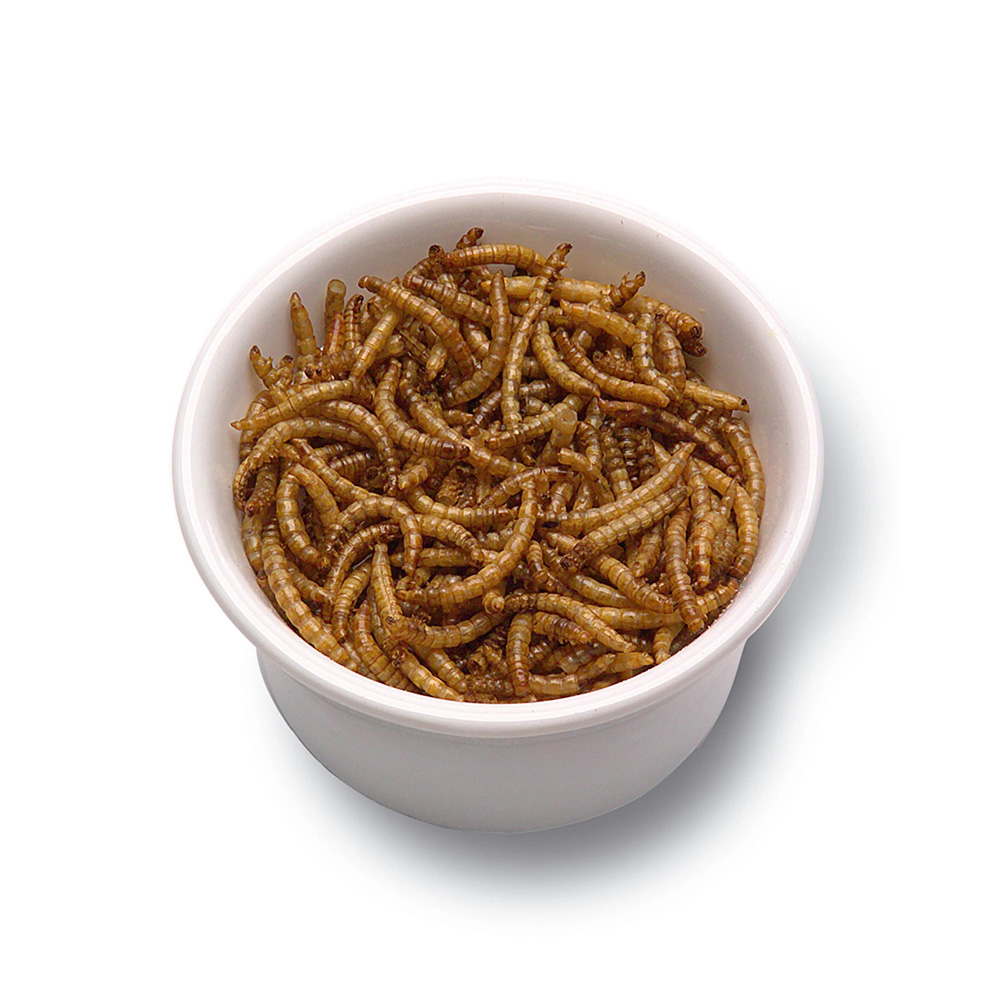
Bluebirds thrive on mealworms because these tiny insects provide a natural, protein-packed boost to their diet. As insectivores, bluebirds instinctively seek out high-protein foods, especially during the breeding season when they need extra energy to raise their young. Mealworms closely resemble the insects bluebirds forage for in the wild, making them an irresistible treat. Offering dried mealworms for bluebirds not only supports their health but also encourages them to visit your yard regularly. This simple addition to their diet can make a big difference in their well-being and activity levels.
Key Takeaways
- Dried mealworms are a high-protein food source essential for bluebirds, especially during nesting season when they need extra energy to care for their chicks.
- Offering mealworms can significantly enhance bluebird activity in your yard, as they mimic the insects bluebirds naturally forage for.
- Use platform or dish feeders to make mealworms easily accessible to bluebirds while protecting them from larger birds and pests.
- Feed bluebirds in the morning with small amounts of mealworms to ensure freshness and encourage regular visits.
- Increase mealworm offerings during critical times like nesting season and winter to support bluebirds when natural food is scarce.
- Dried mealworms are convenient and cost-effective, with a long shelf life that makes them a practical choice for year-round feeding.
- Soaking dried mealworms in warm water can enhance their appeal, making them softer and more enticing for bluebirds.
The Nutritional Benefits of Dried Mealworms For Bluebirds
High Protein Content
Essential for muscle development and feeding growing chicks during nesting season.
Protein plays a vital role in the growth and health of bluebirds. Dried mealworms, with their impressive protein content, provide the nutrients needed for muscle development. During the nesting season, parent bluebirds work tirelessly to feed their chicks. Offering mealworms ensures they have the energy and resources to support their young. Studies show that feeding around 15 to 20 mealworms daily to a nesting pair can significantly enhance chick development. This makes dried mealworms an excellent choice for bird enthusiasts looking to help bluebirds thrive.
Energy-Rich Food Source
Provides the energy needed for migration and daily activities, especially in colder months.
Bluebirds are highly active birds that require a steady energy supply to sustain their lifestyle. Dried mealworms serve as a quick and efficient energy source, especially during colder months when natural food becomes scarce. These tiny treats help bluebirds maintain their body temperature and stay active even in challenging weather. Additionally, mealworms provide the stamina needed for migration, ensuring bluebirds reach their destinations safely. By adding dried mealworms to their diet, you can give these birds the boost they need to tackle their daily adventures.
Mimics Natural Diet
Bluebirds are insectivores, and mealworms closely resemble their natural prey, encouraging regular visits.
Bluebirds naturally forage for insects in the wild, making mealworms a familiar and appealing food option. Dried mealworms mimic the texture and taste of their natural prey, encouraging bluebirds to visit feeders regularly. This connection to their instinctive diet not only attracts them but also supports their overall well-being. Birdwatchers often notice an increase in bluebird activity when mealworms are introduced to their yards. Soaking dried mealworms in warm water for a few minutes can make them even more enticing, as it softens the texture and enhances the flavor.
How to Feed Dried Mealworms to Bluebirds
Choosing the Right Feeder
Use platform or dish feeders to make mealworms accessible and protect them from pests.
Selecting the right feeder plays a crucial role in successfully feeding bluebirds. Platform or dish feeders work best because they provide an open and accessible space for bluebirds to land and feed comfortably. These feeders also help keep mealworms visible, making it easier for bluebirds to spot their food. To prevent larger birds or pests from stealing the mealworms, some bird enthusiasts recommend using feeders with protective covers or designs specifically made for bluebirds. For example, mealworm feeders with small entry holes can limit access to only smaller birds like bluebirds, ensuring they get their share of the treat.
Feeding Tips for Success
Offer mealworms in small amounts during the morning when bluebirds are most active.
Timing and portion size matter when feeding dried mealworms to bluebirds. Bluebirds are most active in the early morning, making this the ideal time to offer mealworms. Placing a small amount of mealworms in the feeder each morning ensures the food stays fresh and prevents waste. Start with about 10 to 15 mealworms per bird and adjust the quantity based on how quickly they eat. Consistency is key—placing mealworms in the same spot daily helps bluebirds recognize the feeding area. For those new to feeding bluebirds, scattering a few mealworms near the feeder can attract their attention and encourage them to visit regularly.
Seasonal Considerations
Increase feeding during nesting season and winter to support bluebirds during critical times.
Bluebirds face unique challenges during nesting season and winter, making these times especially important for providing extra nutrition. During nesting season, parent bluebirds need more energy to care for their chicks. Offering additional mealworms helps them meet the increased demand for protein and energy. In winter, natural food sources like insects become scarce, leaving bluebirds reliant on alternative options. Dried mealworms serve as a convenient and nutritious solution during these colder months. To support bluebirds effectively, increase the amount of mealworms offered during these critical periods. This simple act can make a significant difference in their survival and overall health.
Practical Considerations: Live vs. Dried Mealworms
Benefits of Dried Mealworms
Easier to store and handle, with a longer shelf life, such as Dpat Queen Natural Dried Mealworms 850g.
Dried mealworms offer unmatched convenience for bird enthusiasts. Unlike live mealworms, they require no maintenance or special care. There’s no need to worry about feeding or housing live creatures. With products like Dpat Queen Natural Dried Mealworms 850g, bird lovers can enjoy a hassle-free feeding experience. These dried mealworms come in resealable packaging, keeping them fresh for up to 12 months. Their long shelf life makes them a reliable option for year-round feeding. Bluebirds and other wild birds benefit from the same high protein and fiber content found in live mealworms, but without the added effort for the feeder.
Storage Tips for Dried Mealworms
Store in a cool, dry place to maintain freshness for up to 12 months.
Proper storage ensures that dried mealworms stay fresh and nutritious. Keeping them in a cool, dry place prevents spoilage and maintains their quality. A pantry or storage cabinet works well, as long as it’s away from direct sunlight and moisture. The resealable bag provided by brands like Dpat Queen makes it easy to keep mealworms fresh after each use. For those living in humid climates, storing the mealworms in an airtight container adds an extra layer of protection. Following these simple steps guarantees that the mealworms remain a healthy treat for bluebirds and other backyard visitors.
Cost-Effectiveness
Bulk purchasing options, like Dpat Queen’s resealable packaging, make dried mealworms a practical choice.
Dried mealworms are not only convenient but also cost-effective. Buying in bulk reduces the overall cost per serving, making it an economical choice for regular bird feeding. Products like Dpat Queen Natural Dried Mealworms 850g provide a generous supply in resealable packaging, ensuring freshness while saving money. This bulk option is especially helpful during peak feeding seasons, such as winter or nesting periods, when bluebirds need extra nutrition. By investing in larger quantities, bird enthusiasts can support their feathered friends without breaking the bank. The practicality of dried mealworms makes them a favorite among both novice and experienced bird feeders.
Dried mealworms are a fantastic food source for bluebirds, offering essential nutrients that mimic their natural diet. These protein-packed treats provide the energy bluebirds need during critical times, such as nesting season and winter. By feeding dried mealworms, bird enthusiasts can support bluebirds’ health and encourage regular visits to their yards. Products like Dpat Queen Natural Dried Mealworms make feeding easy and practical, thanks to their long shelf life and convenience. Start offering dried mealworms today to nurture these beautiful birds and enjoy their vibrant presence in your backyard.
FAQ
How to Feed Mealworms to Bluebirds?
Bluebirds enjoy both live and dried mealworms. To feed them, place mealworms in a platform or dish feeder where they can easily access the food. Mixing mealworms with seeds or fruits can also attract bluebirds. For live mealworms, ensure they come from a reliable supplier to provide a balanced mix of protein, fat, calcium, and fiber. This guarantees the best nutrition for the birds.
How Many Mealworms Should You Feed Bluebirds?
Feeding bluebirds requires a balanced approach. Offer around 5 to 10 mealworms per adult daily. During the breeding season, increase the amount to 15 to 20 mealworms for a nesting pair. This extra protein helps them raise their chicks. Always provide fresh water alongside the mealworms to support their digestion and overall health.
How Do Bluebirds React to Dried Mealworms?
Bluebirds, especially Eastern Bluebirds, readily accept dried mealworms. In the wild, they eat live insects, berries, and fruits. Dried mealworms offer a convenient alternative, particularly in winter when natural food is scarce. Bird enthusiasts often notice that bluebirds quickly adapt to this nutritious option, making it a favorite among birdwatchers.
What Is the Significance of Mealworms in Bluebirds’ Diet?
Mealworms are a vital part of a bluebird’s diet, especially during the breeding season. These larvae provide the high protein content needed for muscle development and chick growth. Bluebirds, being insectivores, naturally gravitate toward insects like mealworms. Including mealworms in their diet ensures they receive the nutrients necessary for their health and energy.
What Is the Preferred Food Choice for Bluebirds During Breeding Season?
During the breeding season, bluebirds require extra protein to care for their young. Mealworms are an excellent choice during this time. They provide the essential nutrients needed for feeding chicks and maintaining the parents’ energy levels. Offering mealworms daily during this period helps bluebirds thrive and ensures successful chick development.
What Is the Common Practice Among Bluebirders Regarding Mealworms?
Many bluebird enthusiasts, or "bluebirders," make mealworms a staple in their feeding routine. In spring, it’s common to see bluebirders offering live mealworms to early-arriving bluebirds. Some even share stories of bluebirds tapping on windows, signaling their desire for mealworms. This practice strengthens the bond between bird lovers and these beautiful creatures.
Can Dried Mealworms Replace Live Mealworms?
Yes, dried mealworms can replace live ones. They offer the same nutritional benefits without the hassle of maintaining live insects. Products like Dpat Queen Natural Dried Mealworms 850g provide a long shelf life and easy storage. Soaking dried mealworms in warm water can make them softer and more appealing to bluebirds, mimicking the texture of live insects.
Why Are Mealworms Important During Winter?
Winter poses challenges for bluebirds as natural food sources become scarce. Mealworms provide a reliable and energy-rich option during this time. Their high protein content helps bluebirds maintain body heat and energy levels in cold weather. By offering mealworms in winter, bird enthusiasts can support bluebirds’ survival and well-being.
How Can You Attract Bluebirds to Your Yard?
To attract bluebirds, create a welcoming environment. Use a platform or dish feeder to serve mealworms. Place the feeder in an open area where bluebirds feel safe. Consistency is key—offer mealworms daily at the same spot. Adding a birdbath with fresh water can further entice bluebirds to visit and stay in your yard.
Are Mealworms Safe for Other Birds?
Yes, mealworms are safe and beneficial for many bird species. While bluebirds love them, other insectivorous birds like robins, wrens, and chickadees also enjoy mealworms. Offering mealworms can attract a variety of birds to your yard, creating a lively and diverse birdwatching experience. Always ensure the mealworms are fresh and stored properly.


